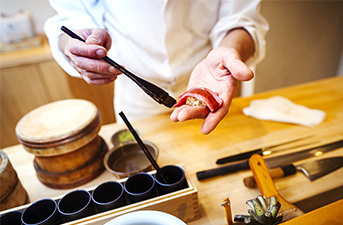Traditional Japanese / Kaiseki / Kappo Restaurants(552)
Ganko Kyoto Station
Transport yourself into the past at this Kyoto Station fixture, which has an eye-catching facade straight out of the Edo period. Popular with commuters looking for a quick bite, it’s also known to be excellent for sukiyaki or kaiseki courses.
CRAFEAT
Conceptualized by a team led by a 10th-generation Wajima-nuri lacquerware artisan, CRAFEAT highlights the beauty of Ishikawa Prefecture’s seafood and produce by serving up impeccable kaiseki-style courses on breathtaking traditional tableware.
XEX ATAGO GREEN HILLS / tempura & sushi An
Located in one of the most cosmopolitan areas of Tokyo, this restaurant has an Iron Chef with over 20 restaurants founded as its advisor. Combined with seafood from the finest suppliers in Toyosu, XEX ATAGO GREEN HILLS is an unmissable destination.
Washoku Uoman (Miyako Hotel Kyoto Hachijo)
In a movement that calls to mind the historic convergence of northern and southern ingredients on the capital, the finest ingredients from all over Japan, like Omi wagyu beef from Shiga, are combined here into traditional kaiseki course menus.
Horumonyaki Koei Honten
The oldest store in the Koei chain of horumonyaki restaurants, this Kabukicho restaurant is said to draw first-time visitors through the smell of grilling offal alone, and make them repeat customers through its affordable — and delicious — menu.
Gion Nanba
Tradition at its finest. Secreted within Kyoto’s traditional district, Gion Nanba offers Michelin-quality kaiseki courses, featuring the best quality produce from all over Japan.
Gion Kurashita
At his Gion restaurant, Chef Kurashita Satoru expertly prepares traditional Kyoto kaiseki, displaying mastery over all ingredients, from king crab and wagyu beef to even the humble tofu.
Kappo Sushi Hana Aza
Three of Fukuoka’s foremost experts in Japanese cuisine depart for an exciting new culinary adventure in the city’s Akasaka district. Novel kappo and sushi creations draw inspiration from cuisine both within and outside of Japan.
Kani Kani Land Kyoto Gion
Originally from Niigata, this restaurant brings the famed snow crab and king crab from off the Sea of Japan's frigid waters to the historic geisha district of Gion in Kyoto.

Kuramoto Ryori Maruto Shoyu
Time, innovation, and flavor converge in an old soy sauce brewery that’s earned a Michelin Green Star. Kuramoto Ryori Maruto Shoyu is revitalizing taste buds while preserving a slice of Nara's history with every perfect dish.

Ginza Kitagawa
Featuring Shiga’s well-known Shinohara style, Ginza Kitagawa’s chefs paint a beautiful canvas of flavors. Each dish in the omakase course perfectly expresses the seasons visually and through flavorful Shiga ingredients.

Mutsukari
This Michelin-starred gastronomic haven seamlessly crafts the pinnacle of traditional Kaiseki cuisine, creating an atmosphere that mirrors the sophistication of its upscale surroundings.

Nishiazabu Noguchi
Chef Shotaro Noguchi’s devotion to kaiseki is shown here at Nishiazabu Noguchi, where he pays homage to his extensive training in Japanese cuisine by adding his own unique touches — a culinary approach that has earned him a Michelin star.
Tan
Taking its name from the Tango Peninsula in Kyoto, Tan’s close relationship with local producers upholds their mutual philosophy of sustainability.
Nihonryori Takayama
At this traditional Japanese restaurant in Hiroshima, Chef Takayama pulls out all the stops to present an omakase course meal using local seafood, with the mission to “make people happy."
Imakoko
The bounties of Ishikawa Prefecture’s Noto Peninsula are masterfully prepared at this Shibuya establishment, founded and run by a world-class chef who once served at the Embassy of Japan in Bolivia.
Akasaka Kenmochi
With seasonal produce sourced from all over Japan and served on traditional ko-imari porcelain, chef Makoto Kenmochi creates course menus that aim to tantalize all of his diners’ five senses.
Ganko Sanjo Honten
While its convenient riverside location, affordable prices and impeccable cuisine draw hundreds of customers a day, many also come to marvel at the traditional Japanese interiors of this Sanjo establishment.
Ganko Kameoka Rakurakusou
Indulge in a succulent sukiyaki or kaiseki course meal beneath the rafters of one of Japan’s Tangible Cultural Properties.
Japanese Restaurant Hamayu (Shima Kanko Hotel)
Delicate, elegant, and high-quality dishes filled with Ise-Shima’s finest seasonal ingredients put on a show at Hamayu, located in one of Mie Prefecture’s most luxurious hotels.
Yamanakako Shogetsu
Traditional nihon-ryori, the foundation of all Japanese food, is served up in kaiseki form at the foot of Japan’s most sacred mountain. Luxury ingredients like soft-shelled turtle and pufferfish have enthralled guests for almost 20 years.
Minokichi Takeshigero Hotel Granvia Kyoto
The Hotel Granvia Kyoto plays host to one of Kyoto’s most historic kyo-kaiseki restaurants, with over 300 years of history serving freshwater fish and other traditional dishes.
Benkei
Indulge in the sprawling menu and premium quality characteristic of Japan’s best hotels at the Nikko Hotel Fukuoka, where Benkei serves high-end Japanese delicacies and home-cooked comfort food with equal skill.
Hamamatsucho Washoku Tempura Yokota
With its original branch in Azabu-juban having held a Michelin Star for eight years, Yokota brings its culinary excellence to the nightlife district of Hamamatsucho. Kaiseki course menus showcase the chefs’ deep understanding of seasonal ingredients.
Sushi & Japanese Cuisine Shinjuku Yonegami
Discover the roots of traditional nihon-ryori through the unparalleled culinary skill of Yonegami’s chefs. Seasonal ingredients, freshly purchased from local sources daily, are crafted into expert displays of hashiri, shun and nagori.
Wami Daisuke
Located in a residential area of Tokyo’s Shirokane district, this Kyoto-style ryotei offers a highly intimate dining experience almost like a supper club, and is frequented by some of Japan’s most famous celebrities.
Kyo-Suiran
Embark on a culinary journey that intertwines cultural heritage, creative cuisine, and the beauty of nature in Arashiyama, Kyoto. Traditional Kyoto cuisine and French gastronomy combine for an unforgettable dining experience.
Ginza Konoha
Even being named one of Japan’s three great wagyu isn’t enough to pass muster at this Ginza kaiseki restaurant. Konoha uses only “maiden beef” in its kaiseki course menus, sourced from young Omi beef cattle that have not yet born calves.
